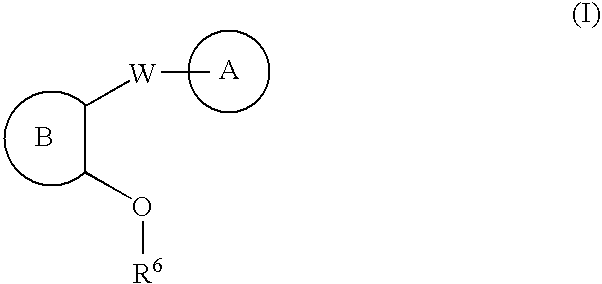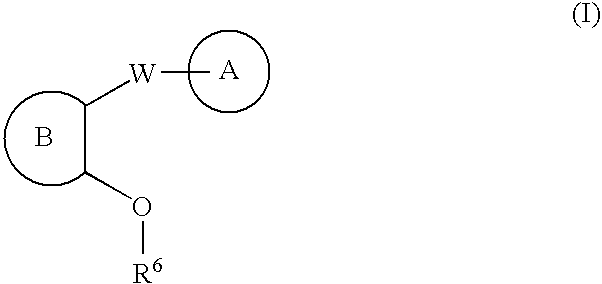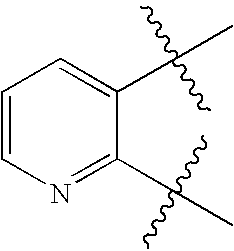Carbocycle and heterocycle antagonists of P2Y1 receptor useful in the treatment of thrombotic conditions
a p2y1 receptor and heterocyclic compound technology, applied in the field of carbocyclic and heterocyclic compound antagonists, can solve the problem that the antagonists lack the necessary pharmacological properties for in vivo study
- Summary
- Abstract
- Description
- Claims
- Application Information
AI Technical Summary
Benefits of technology
Problems solved by technology
Method used
Image
Examples
example 1
methyl 3-(2-(2-tert-butylphenoxy)pyridin-3-ylamino)benzoate
[0271] To a solution of Intermediate 1 (100 mg, 0.414 mmol) in 1,2-dichloroethane (4 mL) in a 25 mL scintillation vial under air was added 3-(methoxycarbonyl)phenylboronic acid (148 mg, 0.818 mmol), triethylamine (120 μL), pyridine (120 μL), powdered 4 Å sieves (150 mg) and lastly Cu(OAc)2 (51 mg, 0.28 mmol). The reaction was stirred overnight (˜16 h) at rt. The reaction was filtered through a 40 μm filter and solvent removed. Purification by flash chromatography (40 g ISCO silica gel cartridge, 0-15% Ether / Hexane) provided Example 1 (93 mg). (M+H)+=377.34. 1H NMR (400 MHz, CD3OD) δ ppm 1.31 (s, 9H), 3.87 (s, 3H), 6.92 (dd, J=8.14, 1.76 Hz, 1H), 7.01 (dd, J=7.92, 4.84 Hz, 1H), 7.11 (td, J=7.92, 1.32 Hz, 1H), 7.19 (m, 1H), 7.34 (m, 2H), 7.42 (dd, J=7.92, 1.76 Hz, 1H), 7.54 (m, 1H), 7.61 (dd, J=4.84, 1.32 Hz, 1H), 7.66 (dd, J=7.92, 1.76 Hz, 1H), 7.73 (dd, J=2.16, 1.76 Hz, 1H); 13C NMR (400 MHz, CD3OD) δ ppm 30.9, 35.5, 52.6, ...
example 2
2-(2-tert-butylphenoxy)-N-phenylpyridin-3-amine
[0272] A solution of BINAP (42 mg, 0.067 mmol) and Pd(OAc)2 (10 mg, 0.044 mmol) in nitrogen degassed toluene (10 mL) was degassed for 10 min. A portion of this solution (1 mL) was added to a 1 dram vial containing Intermediate 1 (30 mg, 0.12 mmol), phenyl bromide (25 mg, 0.16 mmol) and Cs2CO3 (80 mg, 0.246 mmol). The reaction mixture was degassed for 5 min. with nitrogen, sealed and heated to 100° C. overnight (˜18 h). Purification by preparative HPLC (C18 28 mm×100 mm, 20-100% solvent B, 10 min. gradient, 4 min. hold, 25 ml / min: solvent A=10% MeOH / Water+0.1% TFA, solvent B=90% MeOH / Water+0.1% TFA) provided Example 2 (32.7, 0.10 mmol). (M+H)+=319.32
Example 5
Methyl 3-(2-(2-tert-butylphenoxy)pyridin-3-yloxy)benzoate
[0273] 5a. 2-(2-tert-Butylphenoxy)-3-iodopyridine: To a solution of 2-(2-tert-butylphenoxy)-3-aminopyridine (3.30 g, 13.6 mmol) in conc. HCl:water (3:4, 70 mL) at 0° C. was added NaNO2 (1.04 g, 15.0 mmol). Gas evolution was...
example 5
[0275] To a solution of Example 5b (11 mg, 0.0406 mmol) in dichloromethane (1.5 mL) in a scintillation vial under air at rt was added methyl 3-hydroxybenzoate (25 mg, 0.164), powdered 4 Å molecular sieves (˜150 mg), Et3N (60 μL), pyridine (60 μL) and lastly Cu(OAc)2 (15 mg, 0.0828 mmol). The reaction vessel was capped and the reaction was stirred at rt overnight. The reaction mixture was diluted with hexane (2.5 mL), and filtered through a 40 μm filter. Solvents were reduced and the residue was loaded to a silica gel column and purified by flash chromatography (0-10% EtOAc in hexane, step gradient) to provide Example 5 (1.49 mg) as a tan solid. (M+H)+=378.21.
PUM
| Property | Measurement | Unit |
|---|---|---|
| Carrier mobility | aaaaa | aaaaa |
| Electrical conductance | aaaaa | aaaaa |
| Electrical conductance | aaaaa | aaaaa |
Abstract
Description
Claims
Application Information
 Login to View More
Login to View More - R&D
- Intellectual Property
- Life Sciences
- Materials
- Tech Scout
- Unparalleled Data Quality
- Higher Quality Content
- 60% Fewer Hallucinations
Browse by: Latest US Patents, China's latest patents, Technical Efficacy Thesaurus, Application Domain, Technology Topic, Popular Technical Reports.
© 2025 PatSnap. All rights reserved.Legal|Privacy policy|Modern Slavery Act Transparency Statement|Sitemap|About US| Contact US: help@patsnap.com



